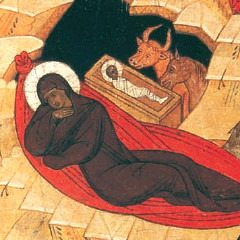
Today marks the start of the Nativity Fast in the Orthodox Church. Like Western Advent, it is a time leading up to Christmas for the faithful prepare our hearts for the coming of Christ.
The period of fasting and preparation mirrors the fast before Easter, or Pascha as we usually call it. Also forty days, from the November 15 to December 25, it is like a little Lent. And not without reason. Christmas and Easter are intertwined. The feasts show the symmetry of God’s providence, that the birth and triumph of Christ are parts of a seamless whole, the saving work of God in human history.
In his book The Winter Pascha Fr. Thomas Hopko notes that the the services of the church intentionally draw worshippers to contemplate this connection.
“The liturgical verses and hymns for Christmas and Epiphany, the Pascha of Christ’s incarnation and manifestation in the flesh, repeat those of Easter, the Pascha of Christ’s death and resurrection,” writes Hopko. “The Lord’s birth and baptism [Epiphany in the Orthodox tradition] are directly connected to His dying and rising. He was born in order to die. He was baptized in order to be raised.”
Hopko provides several verses from the abovementioned services. Two I want to share are particularly moving for me:
Today He who hung the earth upon the waters is hung upon the tree.
And:
Today He who holds the whole creation in His hand is born of a virgin.
These are powerful lines worthy of deep contemplation. They point to God in his power and reveal his divine condescension, his voluntary humiliation. The creator of the universe allowed himself to be cradled in the arms of his creation. The maker of men allowed men to nail his flesh to the cross.
Paul makes the same point about Christ in his letter to the Philippians:
[T]hough he was in the form of God, [Christ] did not count equality with God a thing to be grasped, but emptied himself, taking the form of a servant, being born in the likeness of men. And being found in human form he humbled himself and became obedient unto death, even death on a cross. Therefore God has highly exalted him and bestowed on him the name which is above every name. . . . (Phil 2.6-9)
Notice how closely Paul links the Incarnation and Resurrection. They are ultimately the same event.
The Nativity Fast and Lent both help us to enter into the mystery of the event. Fasting is about emptying ourselves so that we can be born in the likeness of Christ. It is about setting aside impediments to learn obedience, a shouldering of the cross, training our hearts to follow Jesus on the road to Golgotha. The feast that follows shows us the fruit of these labors, the celebration of God’s victory in Christ over sin, death, and the devil.
As the commercial holiday season dominates our landscapes, the Nativity Fast can prepare our inner landscapes for the birth of our Savior, to make ready the cave and manger for his coming.












